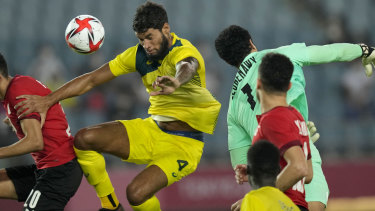Soccer balls should be sold with health warning, says dementia expert
The risk of developing neurodegenerative disease in former professional soccer players varies by position and career length but not by playing era, according to a landmark study.
Research from Professor Willie Stewart, who leads the FIELD (Football’s Influence on Lifelong Health and Dementia Risk) study, previously found that former footballers are three-and-a-half times more likely to die with dementia than the general public.
Australia’s Jay Rich-Baghuelou lines up a header in the Olyroos’ clash with Egypt at the Tokyo Olympics.Credit:AP
New research has shown that outfield players were four times more likely to be diagnosed with neurodegenerative disease, with the risk being highest among defenders, who are five times more likely to have dementia than non-footballers.
The study, which compared health records of 7,676 Scottish male players, found the risk increased with the length of their careers, but the findings remained the same for players regardless of the era in which they competed.
“With the current data, we’re now at the point to suggest that footballs should be sold with a health warning saying repeated heading in football may lead to an increased risk of dementia,” Stewart said.
“The data from this paper is the missing link in trying to understand this connection between sport and dementia… There is no other proposed risk factor, and this is one we could really address and eliminate this disease.
“I think football has to ask the difficult questions: is heading absolutely necessary to the game of football? Is potential exposure to degenerative brain disease absolutely necessary? Or can some other form of the game be considered?”
Last week, the Football Association (FA), Premier League, and other governing bodies announced guidelines limiting “high-impact” headers to 10 per week in training from the 2021-22 season onwards.
Stewart criticised the rules, which were implemented as a precautionary measure, arguing they were based on “unscientific guesswork”.
“There is no basis on which to say 10 headers of a certain level will somehow produce no risk, or even make a great difference to risk. It is a best guesstimate and we would have to wait 30 or 40 years to see the impact,” he said.
The research, funded by the FA and the Professional Footballers’ Association (PFA), was conducted by the University of Glasgow and published in the journal JAMA Neurology on Monday.
Sports news, results and expert commentary. Sign up for our Sport newsletter.
Most Viewed in Sport
From our partners
Source: Read Full Article

